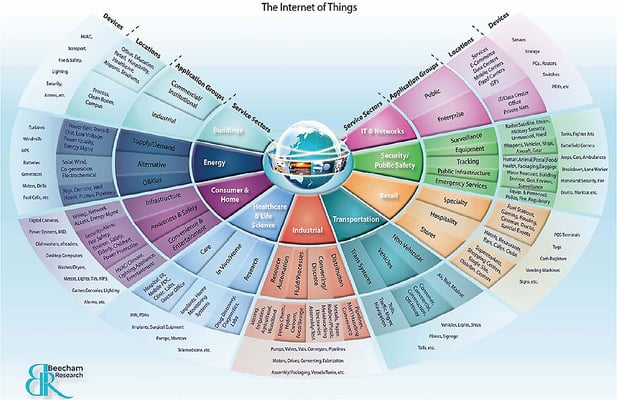In 2012, IBM estimated that the number of devices that were expected to be connected to the internet by 2015 would be in 1 trillion. It turns out that number was an overestimation. Other sources put the number closer to 15 billion in 2015 with device growth expected to reach 75 billion by 2025 . While the first estimate might have been a bit off the mark, what is clear is that IoT sensors and devices are proliferating throughout consumer, industrial and public-sector applications and infrastructure.
What is IoT?
The internet of things consists of networks of sensors and smart devices interacting with the environment, within an ecosystem of other products, and with customers to provide real time feedback about how they are functioning and allow for control, configuration or autonomous operation. The implications are far reaching. IoT applications will help anticipate and diagnose problems allowing for corrective action or preventative maintenance, allow for optimization of operating conditions and parameters, update and adapt functionality, allow for remote control and operation or in some cases enable autonomous operation. These capabilities enable reduced costs by improving efficiency, lowering maintenance spend and reducing or eliminating downtime, improved functionality by adapting products based on actual usage and lower operational costs through reduced operator headcount by allowing fewer workers to monitor and control more systems or allowing those systems to run themselves.
At the minimum, IoT requires a sensor to collect the data, a network on which to transmit data, and an application to process data and allow for interactions or interventions. In the case of physical control of devices and equipment, actuators complete the feedback loop. Nest thermostats, smart phones, autonomous vehicles, utility infrastructure, vending machines, electronic signage, point of sale terminals, parking meters, traffic lights, manufacturing systems, commercial building controls, smart home appliances and printers are all examples of IoT devices and applications.
An interesting graphic with applications by sector by Beecham Research.
What IoT Means to the Enterprise
IoT will fundamentally change the value proposition and reshuffle value chains across every industry. For example, the role of distributors of consumable supplies will change when devices can order their own replenishment directly from a manufacturer. The nature of field maintenance services will change when products can monitor their health and operation, predict maintenance needs and order service proactively (again, perhaps directly from a manufacturer) rather than breaking down and causing an outage. This will reduce the need for redundant and backup systems by improving uptime and reliability.
Working hand in glove with IoT are the machine learning and artificial intelligence algorithms that will process the large volume of data for signals that reveal usage patterns, predict outages and failures, diagnose problems and perform fixes. When systems can repair themselves and adapt to user needs, it will reduce the demand on call centers and improve the customer experience.
Organizations will need to streamline customer interactions, remove friction from transactions and digitize the end to end relationship with suppliers, customers, and employees in order to fully realize the value of IoT.
IoT will allow products to be monitored, controlled and configured in response to environmental conditions, changing customer needs and usage patterns allowing the organization to better serve customers.
Product Data and the Product Life Cycle
Data is the lifeblood of IoT and product data is a foundational requirement for interpreting data in the context of a product’s lifecycle. Organizations will need to incorporate feedback loops consisting of product performance data into product design, engineering and evolution of new functions and capabilities. This will speed the cycle of design iterations by shortening the time for performance, reliability and usability information to reach product designers, usability experts, materials scientists, manufacturing engineers each of whom can see the real-time and near real-time implications of their decisions.
IoT is part of the trend toward faster decision times, faster design cycles and faster clock speeds of the connected enterprise. Product data is becoming the focal point for IoT because products are the “things” that are consuming and producing data. IoT is enabling software configured products, self-managing, self-healing and self-repairing products, and products that are operating in a self-optimizing ecosystem of other products, systems and applications. By optimizing and speeding the data flows throughout that ecosystem and throughout the enterprise, across the various functions that are supporting the customer across their lifecycle, the organization is improving its agility in the marketplace and creating a competitive advantage by being tuned in to how its products are performing in the real world. IoT is part of the inexorable path to intelligence distributed throughout our world responding to our needs and improving efficiencies through optimized data flows. Having one’s product data house in order will be table stakes in the world of connected distributed intelligence.
For a look into how digital product data, managed in a Product Information Management (PIM) system, can be used to power product search, search refinement, and product relationships. Read our whitepaper: B2B - World-class Customer Experience Requires World-class Product Data.

